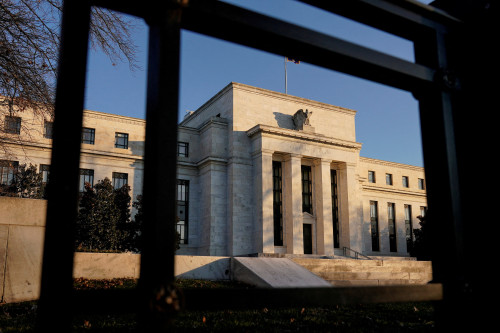
By Howard Schneider, Ann Saphir
WASHINGTON/SAN FRANCISCO (Reuters) -U.S. Federal Reserve staffers have scrambled since January to decipher what Trump administration trade policies will mean for the economy, with published tallies of potential income losses, inflation estimates running as much as 2 percentage points higher, and breakdowns showing state-by-state winners and losers.
The research papers and notes, at least a dozen and counting, have taken different approaches to estimate the implications of the still evolving trade war, which has pushed U.S. import taxes to levels not seen in decades and, at times, to their highest since the Great Depression.
Given the shifting administration announcements, with some of the stiffest tariffs now on hold, none stands out as a definitive take.
But the research effort has been systemwide and steady, reflecting the overarching role of trade policy in the national economic debate and in Fed deliberations over monetary policy.
The Fed held its policy interest rate steady in the 4.25% to 4.5% range at its last meeting, with officials saying they are reluctant to change it until they know which way inflation and jobs will pivot. Minutes of that meeting will be released on Wednesday and may provide more detail about how Fed staff and policymakers perceive the impact of the tariffs imposed so far.
Fed governor Christopher Waller said in a May 14 speech the central bank is in “firefighting” mode to understand what he has called “one of the biggest shocks to affect the U.S. economy in many decades” — an all hands effort to analyze a potential rewrite of the global trading system after decades of closer economic integration among nations.
After Trump’s April 2 tariff announcements proved larger and more extensive than anticipated, “questions were asked of staff around the Federal Reserve system such as, ‘What will this do to the U.S. economy? What will happen to inflation and unemployment?,'” Waller said “The answers to these questions are obviously time sensitive.”
The ongoing research, Fed officials say, will be particularly useful once the final tariff rates and any retaliatory steps by other nations are in place.
But staff’s initial findings and analysis may already be influencing the debate, generally undergirding Fed officials’ topline conclusion that tariffs will raise prices paid by U.S. households and lower purchasing power.
Administration officials argue that the tariffs and trade details they will impose or negotiate will raise money for the U.S. Treasury and boost U.S. manufacturing jobs without sparking higher inflation.
INFLATION IN FOCUS
Fed researchers have been particularly keen to understand how import taxes influence prices, a complex process that depends on things that shift in reaction to each other, like the willingness of producers or retailers to offset tariffs with lower profits, and the ability of consumers to pay more for imported goods, change what they buy, or forego some purchases altogether.
A May note by Fed board economists estimated that the tariffs imposed on China in February and March had already added about a third of a percentage point to goods prices excluding food and energy in the first months of the year, and that but for the tariffs those prices would have fallen — a conclusion that helps explain why policymakers are reluctant to cut interest rates until they know more about inflation that may be in the pipeline.
Larger tariffs have been put in place since that study was done, and even bigger ones are threatened.
“Once we start to get some clearer contours, I think that’s the time to really start to use these models more robustly, ” Atlanta Fed president Raphael Bostic said in comments to reporters on May 20 in Florida.
A Boston Fed study in February of general inflation and an Atlanta Fed study released the same month looking at everyday consumer items both saw prices moving higher, with the estimates depending on the tariffs used to make the estimates.
The fact that the final level of tariffs remains in such flux is another factor keeping Fed officials on the sidelines. Trump has said there will be a baseline tariff of 10% on imports, but some of the paused tariffs exceed 100%, and unexpectedly on Friday the president said there would be a 50% tariff on all imports from the European Union and a 25% levy on all imported iPhones.
CONSUMPTION AND INCOME
Along with rising prices Fed officials are concerned about how changes in trade policy may influence U.S. economic growth if consumers, for example, are left with less purchasing power.
The Dallas Fed in May highlighted one of the hurdles to sorting that out. The outcomes for the U.S. economy depend heavily on whether other countries respond to Trump’s tariffs with retaliatory levies on U.S. exports.
A 25% across-the-board tariff without retaliation could actually boost U.S. consumption by around 0.5%, assuming that proceeds from the tariffs were funneled back to consumers, perhaps through tax cuts.
The same tariffs with retaliation lead to an overall 1% decline in consumption, unevenly distributed across states with effects ranging from a 2.9% decline in Washington state to a 2.6% boost in Wyoming. As with any tax, tariff impacts vary from location to location based on the structure of the local company, with states that are exposed to global supply chains or whose citizens consume more imported goods likely to be hit harder than others.
San Francisco Fed researchers, meanwhile, published a working paper in May that showed high tariffs and retaliation from other countries would lower inflation-adjusted income by 1% nationally, with the biggest hits felt in California, Texas, and the important political swing state of Michigan.
RAISE PRICES OR FIRE WORKERS?
Along with quantitative studies, the Fed has fielded surveys to ask businesses how they may respond to rising tariffs, a staple issue also in conversations officials and staff are holding around the country to sense whether firms are primed to raise prices or fire workers.
Boston Fed researchers, in a survey of small business tariff-related expectations conducted just before Trump took office, found that firms on average anticipated less-aggressive tariffs than actually seen, with 20% tariffs seen imposed on China, 15% on Mexico and non-Asian countries, 14% on Europe, and 13% on Canada. The firms indicated they would pass cost increases to consumers over two years; non-importers felt tariffs would have little impact on prices and potentially lower their costs.
The Cleveland Fed in April published results of a February survey of regional businesses.
The firms largely expected that while tariffs would lead to higher input costs, higher selling prices, and lower demand, there would be no effect on employment — a finding that also buttresses U.S. policymakers’ willingness to keep interest rates on hold given a still, relatively strong, job market.
(Reporting by Ann Saphir and Howard Schneider; Editing by Anna Driver)




